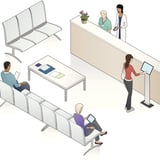
If you live in a rural area, you are probably used to waiting weeks to see a dermatologist. While you might be used to this delay and have learned to plan ahead, have you ever wondered why there are increasingly long wait times? Recent studies estimate that there are about 3.3 derms per every 100,000 people, which means there simply aren't enough doctors to treat all patients. "It is expensive to train dermatologists, and funding for these programs is not keeping pace with societal needs, particularly given the skin cancer and sun damage epidemic," said dermatologist Dr. Craig Kraffert, MD.
Skin cancer organizations have done an excellent job raising public awareness of the disease, which means more people are flooding dermatology practices to get checked. But as anyone who has ever googled "mole or cancer" knows, frantic internet searching of skin issues can lead to minor hysteria. "Doctor Google can fuel fear," said Dr. Purvisha Patel, a dermatologist based in Memphis, TN. "That will lead to an increase in demand for appointments, which causes longer wait times."
"Finding a dermatologist that accepts your insurance and is available seems to be a growing issue."
We have student loans to thank for six-week-long dermatologist wait times, too. "Dermatology is one of the most competitive specialties when applying for residency, because there are not a lot of training programs in the nation," Dr. Patel said. These programs only take about two to 10 new graduates each year, which means university health centers are churning out fewer doctors. "These graduates are generally eager to pay off their exorbitant student loans, and since they're so in demand, they can choose where they want to live." Because of this, they often end up in large cities, so those who live in the suburbs and rural areas are out of luck.
To help areas that need the most help, dermatologists have called in backup. "Physician assistants or nurse practicioners practice under the supervision of a board-certified dermatologist, which enables more patients to be seen in a timely manner," she said. For timely but not life-threatening problems such as acne, you can download apps such as Curology and First Derm. Both platforms allow you to text a dermatologist pictures and questions about a skin condition.
For some, getting face time with a dermatologist is just half the battle. Dr. Rachel Nazarian practices with Schweiger Dermatology Group in NYC, a traditionally overserved area. "Finding a dermatologist who accepts your insurance and is available seems to be a growing issue," Dr. Nazarian said. "Since I take many insurances that other physicians do not accept such as Medicaid, some people come in from farther distances to see me. That's what keeps my schedule so full."
Despite these setbacks, dermatologists across the board agree that longer wait times are not discouraging patients from setting up appointments. "Most dermatologists have increased their hours and availability to accommodate the growing need for appointments," Dr. Nazarian said. Plus, practices triage visits, which means they book appointments first for urgent concerns. "If anyone is dealing with skin cancer, painful lesions, or rashes, we see them ASAP," Dr. Patel explained. That means if you ever have a skincare emergency, practices will make space to see you.
from POPSUGAR https://www.popsugar.com/beauty/Why-Shortage-Dermatologists-45150089
via IFTTT